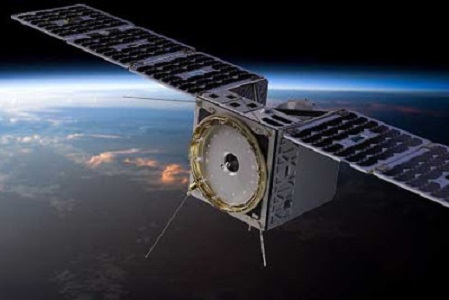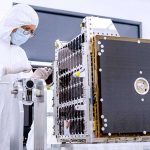To manufacture the MP42 and match microsat mission needs, most of NanoAvionics subsystems only required minor adjustments.
 Smallsat mission integrator NanoAvionics aims to capture a share of the lucrative microsatellite segment with the first modular microsat bus in the industry, the MP42. With 10,000 smallsats scheduled to be launched over the next 10 years, NanoAvionics expects to grow fivefold in size across its entire service portfolio for nano and microsatellite missions and produce about 120 satellites each year by 2025.
Smallsat mission integrator NanoAvionics aims to capture a share of the lucrative microsatellite segment with the first modular microsat bus in the industry, the MP42. With 10,000 smallsats scheduled to be launched over the next 10 years, NanoAvionics expects to grow fivefold in size across its entire service portfolio for nano and microsatellite missions and produce about 120 satellites each year by 2025.
NanoAvionics microsatellite buses are the latest addition to the company’s end-to-end smallsat mission infrastructure aimed at constellations, covering mission design, production, launch brokering, ground segment and satellite operations.
By repeating its successful and cost-efficient approach for nanosatellite bus design, manufacturing and integration, NanoAvionics estimates to provide similar cost savings with its microsats. It allows companies to reduce their CAPEX, receive rapid integration and deploy their spacecraft much quicker compared to other existing solutions in the market without compromising on quality and reliability.
NanoAvionics significantly shortens the time to customise a satellite and lowers the overall price of a spacecraft by keeping about 80% of the flight-proven architecture consistent for each mission and by using modular subsystem manufactured in advance and in larger quantities.
NanoAvionics expects that these measures and results will also significantly lower the entry barriers for companies requiring microsatellites. In particular for various types of telecommunication and remote sensing as well as applications that need high data throughputs such as complex and emergency communications missions, and fundamental research. To cater for these missions, the new MP42 bus for microsats is capable of accommodating payloads in the range of 50 kg and withstand 25kRad of radiation ensuring up to 10 years of lifetime in LEO, depending on the orbit.
All of NanoAvionics facilities in Lithuania, the USA and the UK are equipped for the production and integration of microsats and can be scaled up for constellation orders. First flights of MP42-based constellation precursors are planned for 2022.
Vytenis J. Buzas, CEO of NanoAvionics, said: The MP42 bus is a significant part of our overall end-to-end approach. It will enable a large number of organisations to enter and benefit from the space market previously prevented by barriers in the microsat segment such as cost, lack of modularity, mechanical restraints and suitable mission operations. Their high-end applications and mega constellation requirements can mostly be carried out with a payload weight of 40kg and above, and I see a big opportunity for lowering cost and lead time reduction in this segment, too.
Nanosatellites have already significantly influenced the space sector by providing low cost and quick access to commercial space applications. Based on our extensive flight heritage related to remote sensing, communications, signal intelligence and scientific missions with nanosats, and the feedback we had from existing and potential customers, moving into the heavier microsat market was a logical step to further grow the business.
Like its nanosatellite buses, NanoAvionics new microsat buses have the same modularity for hard- and software and overall mission operations. To manufacture the MP42 and match microsat mission needs, most of NanoAvionics subsystems only required adjusting without an extended effort.
In addition to these adjustments, NanoAvionics introduced its upgraded payload controller to maximise data-exchange and support payload operations. It will be the default equipment for its microsatellite buses and an optional component for its nanosatellites. The microsatellites will be deployed by using a different method compared to the companys nanosatellite buses. Instead of a standard CubeSat deployer, adding about 5-8kg and increasing launch costs, NanoAvionics designed the microsat bus system to be deployed from a 15-inch separation ring.
Other modifications and optional enhancements for microsat missions with the MP42 include PC 2.0 which includes AI reinforced on-board payload data processing, maximised data exchange rates, and the possibility to implement customer software blocks similarly as in mobile phone application cases, Intersatellite link for uninterrupted real-time communications, High-rate downlink, and other features related to mission control software and flight equipment.
















































































